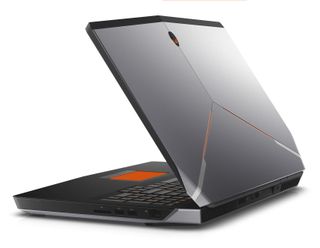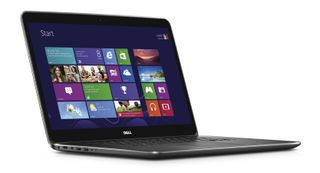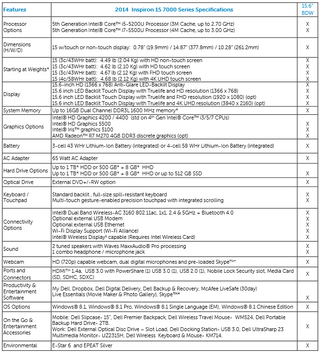Dell Updates Notebook Lineup With Alienware, XPS And Inspiron SKUs
Predictably, Dell brought a number of new SKUs with it to CES. The company has updated its line of Alienware gaming notebooks, as well as its Inspiron and XPS family of notebooks.
Alienware 15 And 17: Thin Is Not In (But Who Cares?)
Although there's a trend in the industry towards insanely thin gaming notebooks, Dell does not appear to be surfing that particular wave. Its two Alienware notebooks look just as thick and chunky as past models, although Dell said that they are, in fact, the thinnest and lightest Alienware notebooks it's built to date.
The new gaming notebooks are available in 15.6-inch and 17.3-inch versions, but oddly, you can only get the high-res UDH option on a 15.6-inch model. Both display options (touch- and non-touch) on the 17.3-inch models only offer 1080p HD.
Both Alienware models feature a carbon fiber-filled base that's designed to be especially rigid, as well as an anodized aluminum lid and internal copper heatsinks.

On the Alienware 15, you can opt for a dual-core Intel Core i5-4210H (up to 3.5 GHz) processor or a quad-core Intel Core i7-4710Q (up to 3.5 GHz) with the option of a factory overclock on the 4710Q up to 3.7 GHz.
Graphics options include up to an Nvidia GeForce GTX 980M (4 GB) or AMD Radeon HD R9 M295X (4 GB), and you can also opt to run desktop-quality graphics via the external Alienware Graphics Amplifier.
Other specs include up to 16 GB of DDR3 1600 MHz RAM and a variety of storage options that range from a single pokey 5400 RPM 1 TB HDD, up to a 512 GB M.2 SSD paired with the aforementioned 1 TB drive.
Audio features include Creative Sound Core3D-EX Audio (with Creative Soundblaster Pro Studio Software), Klipsch-certified 2.0 speakers and 7.1 output via HDMI. Networking options include a gigabit Ethernet Killer NIC and Killer 1525 802.11ac 2x2 WiFi and Bluetooth 4.1.
Stay on the Cutting Edge
Join the experts who read Tom's Hardware for the inside track on enthusiast PC tech news — and have for over 25 years. We'll send breaking news and in-depth reviews of CPUs, GPUs, AI, maker hardware and more straight to your inbox.

The Alienware 17 offers the same storage options and memory as the Alienware 15, but different CPU and GPU options. The 17 SKUs run either a quad core Intel Core i7-4710HQ (up to 3.5 GHz) or a quad core Intel Core i7-4980HQ (up to 4 GHz), and you can opt for factory overclocks up to 3.7 GHz and 4.4 GHz, respectively.
For graphics, the options are either an Nvidia GeForce GTX 970M (3 GB) or a 980M (4 GB). The Alienware 17 can also come with the Graphics Amplifier.
And of course, being Alienware rigs, both the 15 and the 17 feature backlit keyboards and touchpads with trillions of color options. They have identical ports, which include a total of four USB 3.0 ports (one with PowerShare technology); mini-DisplayPort and HDMI 1.4 out; a 9-in-1 card reader; audio out and line in; a gigabit Ethernet jack; and a Noble Lock port. They also have a 2MP Full HD webcam with dual mics, 8-cell 92 Wh batteries, and a special Alienware Graphics Amplifier port.
All things considered, these Alienware machines aren't that terribly expensive; the Alienware 15 starts at $1,199, while the Alienware 17 starts at $1,499.
Holy High-Res Displays: XPS 13 & 15
The most notable feature of the new XPS 13 is its UltraSharp Quad HD+ display. Dell calls it an "infinity display" because the bezel around the screen is so thin, at just 5.2 mm. The company wanted to fit a 13.3-inch screen into a form factor more akin to an 11-inch laptop, and the unit is indeed compact at just 11.98 x 7.88 x 0.33 inches (W x D x H).
What's more, the resolution is a startling 3200 x 1800 (although there's also at least one SKU with a Full HD option). The IPS display also features 170-degree viewing angles, a 1000:1 contrast ratio and 400-nit brightness.

One other feature that jumps out from the spec list is the XPS 13's purported battery life, which is rated at a seriously impressive 15 hours. We'll believe that when we see it, but if Dell is even close to accurate on that number, this laptop boasts truly all-day battery life. That's a major selling point, and it's even more notable when you consider the demands that the high-res display will make of the battery.
Dell says you can get another 8 hours of juice with its 12,000 mAh Dell Power Companion.
The bigger brother in the XPS family, the XPS 15, has a slightly higher-res display that offers 3840 x 2160 Ultra HD and 10-point touch capabilities. It has 160-degree viewing angles, as well as the same 1000:1 contrast ratio and 400-nit brightness. There are also UltraSharp QHD+ (3200 x 1800) and Full HD display options, both touch-enabled.
Although Dell calls this an "infinity display" as well, it clearly doesn't offer the same bezel thinness as its little brother, the XPS 13.
The XPS 13 runs Intel's integrated HD Graphics 5500, which is fine for a notebook, but the XPS 15 offers an option with discrete Nvidia GeForce GT 750M (2 GB) graphics. That feature comes with the Intel Core i7-4702HQ (quad-core) option; the XPS 15 with the quad-core i5-4200H chip only offers Intel HD Graphics 4400.
You get 4 GB or 8 GB of DDR3 1600 MHz RAM on the XPS 13, and twice that on the XPS 15. Storage options on the XPS 13 are simple — you can choose from a 128 GB, 256 GB or 512 GB SSD. The XPS 15 offers a spacious 1 TB HDD with a 32 GB SSD, or only a 512 GB SSD.
The XPS 13 starts at just $799.99, but that price reflects a Core i3 chip, the Full HD display, 4 GB of RAM (instead of 8 GB), and a rather diminutive 128 GB SSD. If you want the highest-end Core i5-5600U option, UltraSharp display and larger 512 GB SSD, be prepared to open your wallet much wider.

The XPS 15 is going to cost a lot more. It starts at $2,349 with the 4K Ultra HD display (we'll wait a moment while you recover from fainting), and it's a little unclear how high that price tag might climb. It's unclear, but we imagine that this price will include the lower amount of RAM (8 GB versus 16 GB) and integrated graphics instead of discrete.
The XPS 13 features two USB 3.0 ports (with PowerShare), mini DisplayPort, an SD card reader, 3-in-1 card reader, headphone jack and Noble Lock port. There's also a 720p HD webcam with dual mics and two 1W Waves MaxxAudio Pro speakers. The XPS 15 is similar, but it has one extra USB 3.0 port as well as a USB 2.0 port (with PowerShare) and an HDMI port.
So. Many. Inspirons.
Dell has also updated its Inspiron lineup; one has a tasty 4K Ultra HD display, and one gets Intel's RealSense camera.
The Inspiron 14, 15 and 17 5000 Series comes in multiple screen sizes, processor, graphics options, and more. It's a bit unclear exactly how many SKUs there are (we counted at least 20), but just to give you an idea, they'll come in 14-, 15.6- and 17.3-inch form factors, in both touch and non-touch variants, while processor options include Pentium and 5th-gen Core i3, i5 and i7 chips.

That's not to mention the multitude of graphics options, which include Intel HD Graphics 5500, AMD Radeon R7 M265 (2 GB), AMD Radeon R7 M270 (4 GB), Nvidia GeForce 820M (2 GB) or Nvidia GeForce 840M (2 GB).
At least three of those configurations include the addition of the RealSense 3D camera (the Front F200 version) on the 15.6-inch touch display models.
It's worth noting that all of these models include an optical drive, a feature that's quickly becoming extinct (or at least irrelevant) on even desktop PCs these days.
So you can see all the nitty gritty details of these various configurations, we'll just leave you with this massive spec chart:

But wait, there's more: Dell also has several Inspiron 7000 Series laptops for your consideration.

The key feature of the 7000 Series lineup is, like the XPS models, the display. Dell offers up to a 4K UHD (3840 x 2160) touch-enabled display, although there are options ranging from 1366 x 768 (non touch) to Full HD (touch), as well. The UHD display features 170-degree viewing angles, 400:1 contrast ratio and 270-nit brightness.
All of the models are 15.6-inch affairs, and they have graphics options from Intel HD 4200 to Intel Iris Graphics 5100 to discrete AMD Radeon M270 (4 GB). All the models have 16 GB of DDR3 1600 MHz RAM.
Another notable feature is the availability of hybrid storage drives. You can opt for a 1 TB HDD or 500 GB hybrid drive, and you can add a 512 GB SSD if you like, as well.
The Inspiron 15 5000 Series starts at $749.99, and that includes the RealSense camera. The Inspiron 7000 Series starts at $1,099.99.

Buried deep in a press release, Dell also mentioned an Inspiron 13 7000 Special Edition, a 2-in-1 that will launch in March in an "Only @ Best Buy" collection. The company did not provide any other details of note, other than it will have a 360-degree hinge, curved edges, a metal palm rest and it will work in four stand modes.
Follow Seth Colaner @SethColaner. Follow us @tomshardware, on Facebook and on Google+.
-
Innocent_Bystander I have an Inspiron 15 7000 series from last year and no major complaints. (i7, GF750M 16GB RAM, 2GB GDDR5 and I swapped the 1TB spinner for a 240GB SSD).Reply
It's a Full HD and I think it could use a downgrade to 1600x900 on a screen this small.
Aside from that there have been some minor hardware complaints that were fixed by Dell sending me the raw service parts for replacement (I like how they show their customers respect and not treat them like idiots - Sony could take note)
This thing is a beauty of serviceability too. Comes apart and goes back together like LEGO. Apple could take a few product design pointers from Dell on that front.
Their customer service is also really good, customized with one tech assigned to your ticket until it's resolved.
Based on my experience another company would have to make a hell of an argument before I'd switch. -
jn77 Whats really bugging me here is the "high end" or gaming laptops are still coming with 1980p screens. I game a little, but my gaming laptop is used more for photo editing and video editing. Whats the deal with the sub par screens on high end laptop's and these cheap laptops coming out with 4k screens all the time, at least 4 generations of them now.Reply -
warezme I would like to see the higher resolution screens on the gaming laptops not the skinny poser girl models. I'm looking to finally upgrade my m17X R3 that was the tiptop at the time with a 580GTXm, quadcore i7 2920XM, 24GB ram and 256GB OCZ Vertex 4 SSD and 500GB storage drive. I keep it lean and mean but the video is starting to get left behind in some games but hangs in most. I was hoping Razer would release a 970m or 980m based 15" laptop but they have been disturbingly quiet regarding their laptop updates for a while.Reply
Most Popular



